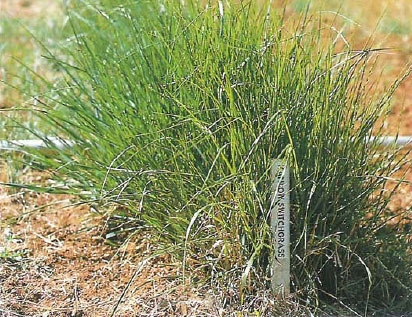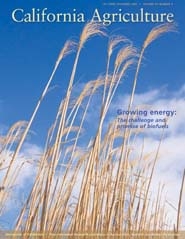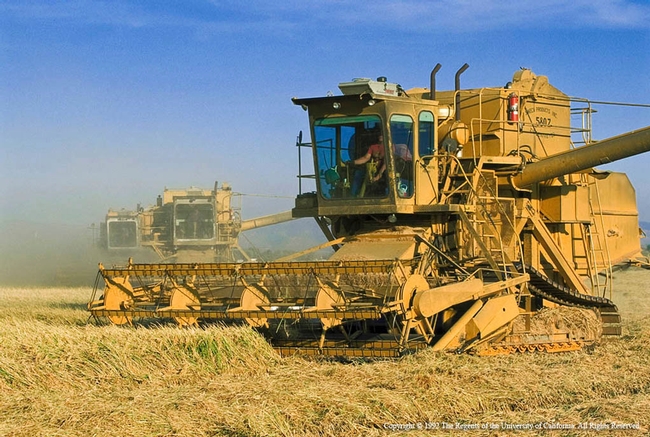Posts Tagged: biofuel
UC looks into a 'healthier' way to use tobacco
Converting tobacco into cigarettes is a dwindling industry, so scientists are looking for an alternative use for the product grown by tobacco farmers, said an article in the New York Times Green Blog.
Peggy Lemaux, UC Cooperative Extension specialist in the Department of Plant and Microbial Biology at UC Berkeley, shared the idea at the annual meeting of Advanced Research Projects Agency-Energy, an agency founded to nurture interesting energy ideas that may or may not work.
Some bacteria and algae turn sunlight into oils that can be burned in a car engine or used as raw material at a refinery in place of crude oil. A research consortium that includes the Lawrence Berkeley National Laboratory, UC Berkeley and the University of Kentucky has taken genes from those types of bacteria and algae and inserted them into tobacco plants. In the first year of work, the efforts produced a crop and organic solvents were used to extract the oils out of the leaves.
For an overview, see the video below:
Rice growers optimistic; seeking biomass growers
The (Marysville) Appeal-Democrat checked in on the rice harvest which started recently, with an article by reporter Ashley Gebb. USDA reports that harvested acreage for rice in California is up 6 percent this year, to 588,000 acres; in 2010, Yuba and Sutter counties had approximately 154,000 acres planted in rice. The reporter talked to Chris Greer, UC Cooperative Extension farm advisor for Sutter-Yuba and Colusa counties, about what this summer's cooler weather means for the rice harvest. "Overall things look pretty good from a yield standpoint," he told the reporter. "We will have to see what the numbers come out. From what we are seeing, we are pretty optimistic on the prospects."
Harvesting jet fuel
Kathy Johnston, (San Luis Obispo) New Times
Reporter Kathy Johnston examined both government and grower interest in camelina sativa, an oilseed crop that can be used in jet fuel. Growers interested in camelina can sign up for USDA's Biomass Crop Assistance Program, the deadline for which has been extended. The reporter talked with Steve Kaffka, UC Cooperative Extension agronimist in Davis and director of the California Biomass Collaborative, who is seeking cooperating growers for trial plantings of camelina under local conditions this winter. “It hasn’t been adapted specifically for California. We’re trying to figure out what conditions it likes, the range of rainfall and soil types where it might be suitable in San Luis Obispo County,” Kaffka told the reporter.
She also talked to Royce Larsen, UC Cooperative Extension natural resources advisor in San Luis Obispo county, who explained that though meetings about the crop have been well attended, no San Luis Obispo growers have signed up for the program yet. “A lot of people showed up [at a meeting about camelina in Templeton] with great interest, but they left, I think, a little downhearted,” Larsen told the reporter. “The bottom line is it’s too new, with too many unknowns for people to want to jump on board and give this a try."
(Though this article is about San Luis Obispo county, other California counties included in this project area are Butte, Colusa, Fresno, Glenn, Kern, Kings, Madera, Merced, Riverside, Sacramento, San Joaquin, Solano, Stanislaus, Riverside, Tehama, Tulare and Yolo, according to an article on the California Ag Network website.)
USDA official promotes renewable fuel infrastructure
A USDA official was in Oakland yesterday to promote the development of renewable fuel infrastructure in the United States, according to a news release from Propel Fuels. The federal agency plans to fund the build-out of 10,000 renewable fuel pumps across the nation in the next five years.
Judith Canales, administrator of USDA's Rural Business and Cooperative Programs, spoke at a press conference held at a gas station where customers can purchase E85 Flex Fuel and biodiesel from Redwood City-based Propel Fuels.
A story produced by KGO-TV in San Francisco said high fuel prices came at a perfect time for Propel, whose biofuel business is booming.
"What we are trying to do is focus on fuels that are domestically made, and fuels that could contribute to American jobs and reduce our dependence on foreign oil," Propel executive Jim Iacoponi told KGO reporter Wayne Freedman.
Most American-made biofuel is produced with corn. Corn is high in starch, but low in sugars, making it less efficient for making fuel than foreign sugar cane. But high U.S. tariffs make corn a viable alternative.
In the news story, UC Berkeley physicist Richard Muller attributed some of the interest in corn to presidential politics.
"Well, it's Iowa," Muller said. "In order to win the Iowa caucuses go to Iowa and promise they will support corn ethanol."
At the news conference, Canales said corn will only be part of the solution.
In the U.S., there are more than 20 million vehicles (more than 1 million of those in California) capable of running on renewable fuels, but the majority do not have access to these fuels. Propel has plans to build 75 additional stations in the Bay Area and Sacramento, as well as in new markets later this year, the news release said.

USDA's Judith Canales fuels a CalTrans vehicle that runs on biofuel.
Biofuel is a growing opportunity for California
Federal law requires annual U.S. production of 36 billion gallons of biofuels by 2022, creating a potentially profitable opportunity for California farmers, according to UC experts quoted in Western Farm Press.
Writer Cary Blake based two stories in the magazine's current issue on the April 2010 Alfalfa, Forages and Biofuels Field Day at the UC Desert Research and Extension Center in El Centro.
The story said UC Davis Cooperative Extension agronomist Steve Kaffka is optimistic about the future of California biofuels production.
"Available solar energy and water make the Imperial Valley one of the prime places in the world where renewable fuels could be produced," Kaffka told the assembly of farmers, pest control advisers and industry representatives.
Additionally, potential California biofuel crops, like switchgrass and jatropha, will likely carry a smaller carbon footprint than Midwest-produced corn ethanol. Information Kaffka shared with field day participants said Midwestern corn ethanol has a higher total carbon footprint than gasoline.
The companion Western Farm Press article provided details on UC research on the biofuels crops switchgrass and jatropha.
UC Davis Cooperative Extension forage specialist Dan Putnam said switchgrass has good yield potential, but more research is needed. Sham Goyal, UC Davis agronomist, said he has never found a plant that is more drought tolerant than jatropha, which has seeds that contain 35 to 45 percent oil.
"This plant can get by on a minimum amount of water," Goyal was quoted. "This very characteristic makes this plant very suitable for the Imperial Valley."

A sample of switchgrass.
Capital Press proclaims the promise of biofuel
An article in the agribusiness newspaper Capital Press about how much money is being spent on research around California to develop alternatives to fossil fuels was picked up from a UC ANR news release touting the most recent issue of California Agriculture journal.
Writer Tim Hearden's story, however, refers in the third paragraph to "the study," when in fact the release reported that more than two-thirds of a billion dollars coming from corporate and government sources are funding dozens of studies taking place at five research locations, according to Janet Byron, managing editor of California Agriculture.
"I'm grateful for the Capital Press story, but it's interesting to see how our material was used," Bryon said.
Also somewhat perplexing was Hearden's use of quotes from UC Davis news service public information representative Sylvia Wright. I tried to contact Wright to find out how the interview came about, but she is not available today.
Much of Hearden's material came directly from the release, so his story serves as another avenue for spreading word about UC research efforts to build better biofuels and help California reach its ambitious goal of a 10 percent reduction in greenhouse gases by 2020.
California farmers, forests and landscapes could produce 30 million tons of renewable biomass for electricity generation, biofuels and industrial processing, the equivalent of 2 billion gallons of gasoline annually, according to Bryan Jenkins, director of the UC Davis Energy Institute.

The Oct.-Dec. 2009 issue of California Agriculture journal

